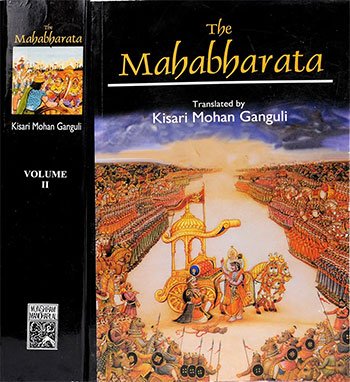Section CXV - Arjuna and Bhima wreak havoc on the battlefield with their arrows
Book index: Mahabharata (English)
This page contains a summary of the Mahabharata Section CXV including examples of moral lessons in daily life. The Maha-Bharata is one of the largest epics ever written containing roughly 100,000 Sanskrit verses. It deals with the legendary history of ancient India and contains a large number of interwoven tales.
Short summary of the chapter:
In the midst of the battle, Arjuna was seen afflicting the Kaurava warriors with his powerful arrows, piercing Salya, Susarman, Kripa, Jayadratha, and other mighty car-warriors. Despite the fierce resistance from the enemy, Arjuna and Bhima displayed their incredible prowess, breaking numerous enemy bows, slaying soldiers, elephants, and horses, and causing great devastation on the battlefield. The two brothers stood out like furious lions amidst a herd of kine, wreaking havoc upon the enemy forces with their exceptional skill and valor. Jayadratha, Citrasena, Kritavarman, and other Kaurava warriors retaliated, but Arjuna and Bhima continued to dominate the battlefield, displaying unmatched strength and courage.
Amidst the chaos, Bhima and Arjuna faced fierce opposition from the likes of Salya, Jayadratha, Drona, and the ruler of Magadha, but they stood undaunted, exchanging formidable blows and arrows with their adversaries. Drona and Jayatsena attempted to pierce Bhima with sharp arrows, but Bhima countered with even greater force, eventually causing Jayatsena's charioteer to lose control and flee from the battle. Meanwhile, Drona engaged in a fierce exchange of arrows with Bhima, but the latter's relentless attack forced the preceptor to retreat from the battlefield, giving the Pandavas the upper hand.
As the battle intensified, Bhishma, Duryodhana, and Vrihadvala joined forces to confront Bhima and Arjuna, leading to a fierce clash between the two sides. The Pandava army, led by Dhrishtadyumna, Sikhandin, and Yudhishthira, rallied together to take on Bhishma, each side fighting fiercely for victory. Bhishma, likened to Death himself, advanced towards the Pandavas, while Sikhandin, filled with determination, faced off against the formidable warrior, determined to make a significant impact on the outcome of the battle. The confrontation between the Kauravas and the Pandavas for the sake of Bhishma's victory or defeat grew increasingly intense, with both sides fighting with unwavering determination and courage.
The battle continued with both sides fiercely contesting the field, determined to either secure victory for Bhishma or overcome the stalwart warrior. Dhrishtadyumna urged the Pandava forces to launch a fierce assault against Bhishma, rallying them to fight fearlessly and dedicate themselves to the cause. The Pandava troops, led by Sikhadin and supported by the Srinjayas, faced the formidable challenge posed by Bhishma, as both sides clashed in a brutal and intense battle. The stakes were high, with Bhishma's victory or defeat holding great significance for the outcome of the battle, as the warriors of both sides fought fiercely, leaving no room for hesitation or retreat in their pursuit of victory.
Full English translation:
This page is merely a summary which is automatically generated. If you are looking for authentic sources such as the Sanskrit text or the Full English translation of Mahabharata Section CXV - Arjuna and Bhima wreak havoc on the battlefield with their arrows, have a look at the following articles:
Section CXV, online text
English translation by Kisari Mohan Ganguli.
Read this and other chapters online.
Mahabharata (English Summary)
by Kisari Mohan Ganguli | ISBN-10: 8121505933
Buy the latest edition:
FAQ of Mahabharata, Section CXV:
What did Arjuna do to the mighty car-warrior Salya in battle?
Arjuna covered Salya with straight shafts and pierced other warriors with arrows in the battle. He also struck Jayadratha, the king of the Sindhus, and others.
How did Bhima and Arjuna rout the fierce host of the Kauravas?
Bhima and Arjuna began to defeat the Kauravas by felling heads of combatants, breaking cars, and causing a great slaughter on the battlefield.
Who did Dhrishtadyumna command the troops to rush against in battle?
Dhrishtadyumna commanded the troops to rush against Bhishma, the grandsire of the Bharatas, in the battle. Bhishma became the stake on which victory depended.
Daily life: Arjuna and Bhima wreak havoc on the battlefield with their arrows:
The narrative from the Mahabharata involving warriors such as Arjuna, Bhima, and Bhishma showcases the intensity of conflict and the resilience exhibited by these characters in the face of adversity. To draw parallels to daily life, one can view the battle as a metaphor for the personal and professional challenges one might encounter. Just as Arjuna and Bhimasena faced their opponents with courage and strategic prowess, individuals can approach their own battles—be they with work deadlines, personal goals, or interpersonal conflicts—with a similar resolve and determination to overcome obstacles.
The episode also underscores the importance of teamwork and leadership, as demonstrated by the Pandavas and their allies rallying together under adverse conditions. This can be a lesson in harnessing the collective strength and support of one’s community or team to navigate through tough times. Moreover, the narrative highlights the value of persistence and adaptability; just as the warriors adapted their strategies in combat, one must be willing to adjust their approaches in life when confronted with new challenges.
Through this lens, the epic's message encourages resilience, strategic action, unity, and adaptability in the face of life’s battles. Engaging with adversity, not as insurmountable obstacles but as opportunities for growth and learning, echoes the spirit of the Mahabharata's warriors. Embracing these principles in daily life can lead to personal development and a sense of fulfillment.
